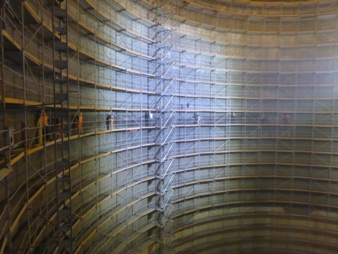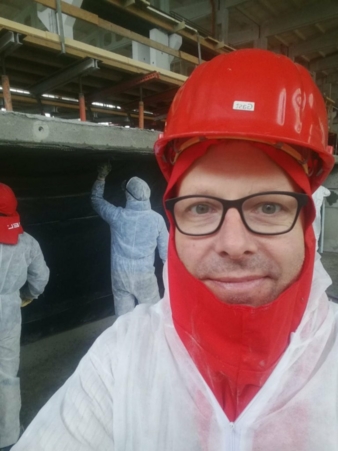27/01/2020 – Tudalit e.V. — auf Deutsch lesen
Carbon concrete – a niche reality?
Textiles of carbon concrete are an original German development with huge potential for multiple applications. Rust-proof textiles make building components lighter, sleeker and more durable.
In a move to build a bridge between two-and-a-half decades of research and applied construction, plans are in the pipeline to develop an industry association with considerable clout. We spoke to Dr. Klaus Jansen, Managing Director of Tudalit e.V.
textile network: Is this master innovation, created and made in Germany, more of a vision than a reality?
Dr. Klaus Jansen: Yes and no. The visions are indeed ambitious. We could use less sand, cement and logistical power to erect buildings and bridges that last two to three times longer than today’s steel-reinforced concrete constructions. A start has been made with numerous demonstration projects which highlight aspects such as maintenance, reinforcement and new builds; but we haven’t done enough to raise awareness and build confidence in this innovation. At the moment, I would say it’s a niche reality. Or in other words: We’re yet to see its large-scale application or major beacon projects because the material still hasn’t been given general approval. What we have here in Germany in terms of pedestrian bridges, cladding or individual builds has arisen from one-off approvals or is the result of a general technical approval issued in 2014. Projects are currently under way to shine a positive light on the technical properties of carbon concrete compared to conventional steel concrete.
textile network: Who is the driving force behind this technology in Germany? Can you think of any textile concrete buildings that could pose as beacon projects for this new technology or ones that are currently under construction?
Dr. Klaus Jansen: Divided into the categories ‘new builds’, ‘maintenance’ and ‘research’, quite a lot has actually been achieved.
New builds: A little known example can be found at the Rotes Haus underground station in Berlin. The newly built line there, no. 55, is clad with 5,000 textile concrete panels with sweeping curves from BNB Potsdam. Bielefeld-based company Goldbeck recently unveiled at the Carbon and Textile Concrete Conference a staff car park with carbon concrete elements, whilst solidian from Albstadt has constructed several bridges from this material as well as cladding for the 300-metre pylons of a bridge spanning the Bosphorus strait; Ginkgo Textilbeton from Dresden produces shells and ellipsoids, whereas Stanecker Betonfertigteilwerk has collaborated with Penn Solutions in Textile and Aachen-based textile research institute ITA to develop the world’s first double-curved textile concrete façade.
Maintenance: The Franconian company V. Fraas – Solutions in Textile (now trading as Kneitz Solutions in Textile) –, a producer of scrims from alkaline-resistant fibres and carbon under the SITgrid brand, and Roy Thyroff from rothycon offer pioneering applications for the reinforcement of finished concrete parts as well as bridge refurbishment. Based in Essen, Torkret is currently using this material to refurbish the Pilgrimage Church in Neviges. Implenia and construction specialist Ammar Al-Jamous have chalked up initial successes in silo refurbishment; CarboCon has refurbished bridges in Naila whilst the specialists at Koch have focused on multi-storey carpark refurbishments and cathodic corrosion prevention.
Research: The German concrete textile research landscape is world-ranking and is most certainly on a level with Silicon Valley for IT. Various projects, which have so far received EUR 45m in funding from the Federal Ministry of Research, are currently running with nationwide building partners within the C³ Consortium, which is managed from Dresden. Important Centres of Excellence for carbon concrete include the Technical University of Dresden and Chemnitz, RWTH Aachen University, the universities of Brunswick, Stuttgart, Dortmund and Kaiserslautern and the Technical University of Munich.
textile network: Textile concrete is of immense importance to Germany as a production location. In fact, one could even say it’s a political issue. What needs to happen here within the next five years to prevent our experts from going abroad?
Dr. Klaus Jansen: This is where “big” politics come in; maybe we need to see a concerted effort with several more million euros in state funding and a clear commitment from investors and well-known construction giants – this may help this globally strategic and innovative construction method to make a breakthrough, both in Germany and Europe.
An industry association, now in its beginnings, can make a huge contribution to encouraging construction companies to opt for C-concrete. To do so, a government framework has to be created and local tenders need to be modified accordingly. Design instructions and dimensioning rules have to be defined and made generally accessible to planners, so that they can actually use the material. At the same time, guidelines and standards have to be identified so that standard reinforcements and concretes for different applications can be used as construction materials.
In our role as an industry association, we can ensure that findings from many existing research projects can be brought together and communicated to construction companies more quickly.
textile network: A little more state and visionaries are what’s required then?
Dr. Klaus Jansen: Exactly! We need more courageous architects, planners and contractors, as well as visionaries in public tendering procedures and in approvals. If you’re thinking of opting for C-concrete, you’ve got to look beyond the construction costs. If you don’t, textile concrete will always lose out to steel concrete. But if we think about overall lifecycle costs, lower logistical costs, the longer service life, lower maintenance costs and the lower carbon footprint, textile concrete wins hands down every time.
textile network: Initial series applications are under way not only in Switzerland but also in India; are others pipping you to the post?
Dr. Klaus Jansen: It’s starting to look that way. The approval procedures work differently in every country and often they don’t take as long elsewhere as they do here in Germany. This means that projects in Switzerland, for example, can be implemented more quickly. The companies affiliated to our association operate internationally. We would certainly like to see quicker implementation particularly in Germany.
textile network: What goals has the association set itself for 2020/21?
Dr. Klaus Jansen: Generally speaking, we want to raise public awareness for C-concrete and its potential. In addition, we want to grow beyond Germany, beyond Austria and Switzerland and across the rest of the EU. We hope the association will gain more clout by attracting users, planners and architects. In terms of content, we wish to support companies launching products onto the market. We’re currently working on professionalising our own organisation and building our own expertise so that Tudalit e.V. becomes the leading service provider for this industry. I’m pretty sure this will involve a change of name and a move from Dresden to Berlin.
textile network: Why the move to Berlin?
Dr. Klaus Jansen: The association is undergoing fundamental reform. We’re aiming to bring the full spectrum of expertise from business and research around one table, and we want them all to have equal weight. This building revolution will only succeed if we all pull together and have the support of politics, too.
Dr. Jansen, thank you for the interview!
The questions on behalf of textile network were asked by Hans-Werner Oertel.





